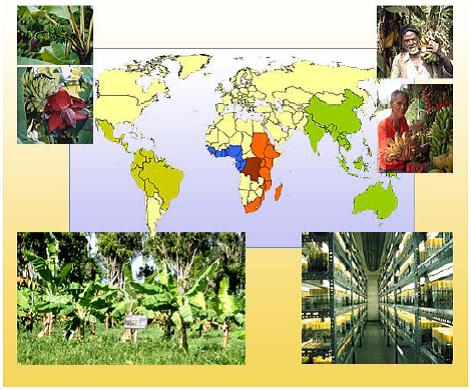Conservation of banana genetic resources
Contributors to this page: Bioversity International, France (Nicolas Roux, Anne Vezina, Max Ruas, Stéphanie Channeliere), Bioversity International, Belgium (Bart Panis, Ines Van den Houwe), Bioversity International, Ethiopia (Michael Bolton, Alexandra Jorge), CIRAD, France (Jean-Pierre Horry), Institute of Experimental Botany (Jaroslav Dolezel), IITA, Nigeria (Dominique Dumet, Badara Gueye).
Importance of banana conservation
 |
|
People in different parts of the world work together to conserve banana diversity |
Genetic improvement of varieties presents a potentially cost-effective mechanism to address current constraints in smallholder production, providing high-performing varieties that can adapt to diverse environments. These potential improvements are drawn from sources of resistance from wild and edible genotypes. However, new wild species and varieties are inadequately represented in collections. Threats posed by habitat destruction and replacement or loss of traditional cultivars intensify the urgency for collection and conservation efforts worldwide (INIBAP, 2006).
Recent banana projects have demonstrated a growing demand for increased diversity of cultivars, improved varieties not only within the research and breeding community but also among smallholder farmers and formal market systems. Supplying banana producers with a wider range of diversity can potentially broaden their livelihood options and can also enable family nutrition to be diversified (INIBAP, 2006).
Conservation of banana genetic resources is together with the other roots and tubers also subject of theme 1 “Conserving and accessing genetic resources” of the CGIAR Research Program on roots, rubers and bananas (CRP-RTB). Theme 1’s overall objective is to build upon the existing competencies of the four CGIAR Centers involved in clonal crop conservation to implement global conservation strategies for RTB crops in close collaboration with the Global Crop Diversity Trust (GCDT) and regional and national genebanks.
The Global Musa Genetic Resources Network, in short MusaNet, is a global collaborative framework for Musa genetic resources and a partnership of all key stakeholders, which aims at ensuring the long-term conservation on a cooperative basis.
Conservation methods
Banana (Musa) germplasm is usually seedless and options for its long-term conservation is therefore limited by the vegetative nature of the plant's reproductive system.
- Vegetative methods are the best and more widely used methods of banana conservation.
- Germplasm can be maintained as vegetatively maintained genotypes in fields or screenhouses (field banks), in tissue culture or via cryopreservation (in vitro).
- When the objective is solely to conserve the genes (but not specific combinations of genes), true seeds can be used instead, as long as seeds are produced. Seeds can probably also be conserved with cryo techniques.
- Genes can also be maintained for further use in the form of DNA (DNA banks or lyophilized leaves) or cryopreserved pollen.
Genebanks should have clear priorities on which type of germplasm should be collected, efficiently conserved and securely duplicated.
- Small collections may also give high priority to conserving all material.
- Larger collections should prioritize the conservation of local landraces.
- If core collections have been defined, these must be given the highest priority.
- Conservation of breeding lines and introductions should given lower priority than conservation of local material.
-
The conservation of local landraces must be particularly secured. Possible measures are:
- Use two separate field locations.
- Duplicate in vitro collections in separate locations.
- Maintain a field bank and an in vitro bank.
- Maintain a back up of the in vitro bank under cryopreserved conditions.
- Maintain a back up of the cryopreserved collection in a separate location as black box.
Major banana collections
It is estimated that there are at least 60 major national collections worldwide. Most banana collections manage their accessions in vivo (as full size plants) in the field. A survey carried out by INIBAP in 2006, reported that 25 field collections of banana hold more than 6000 accessions.
About 15 of the surveyed institutes (INIBAP, 2006) host in vitro collections containing slightly more than 2000 accessions, in addition to the Bioversity International Transit Centre (Bioversity ITC) that holds a further 1176 accessions (in vitro).
Cryopreservation methods were first developed at Bioversity ITC in 1996, and work to cryopreserve their entire banana collection started in 2003. The ITC has until now (situation September 2013) cryopreserved 882 accessions belonging to all Musa groups. This represents 63% of the accessions stored in vitro and is thus one of the world’s largest cryopreserved plant collections percentage wise. The National Research Centre for Banana (NRCB) in India and the International Institute of Tropical Agriculture (IITA) in Nigeria are also initiating working on some cryocpreservation methodologies.
Relevant banana collections with rich germplasm diversity or which provide relevant research, expertise, services or capacity building include: BPI, Philippines; CARBAP, Cameroon; CIRAD, France; DHIA, Honduras; DPI&F, Australia; EMBRAPA, Brazil; IEB, Czech Republic; IITA, Nigeria and Uganda; ITC, Belgium; University of Gembloux, Belgium; NARO, Uganda; NRCB, India; PPRI, South Africa; SPC, Fiji.
References and further reading
INIBAP. 2006. Global Conservation Strategy for Musa (Banana and Plantain). Available from: www.croptrust.org/documents/web/Musa-Strategy-FINAL-30Jan07.pdf. Date accessed: 23 March 2010.
MusaNet [online]. Homepage of the MusaNet portal. Available from: https://sites.google.com/a/cgxchange.org/musanet/home Accessed: 25 July 2011.
Panis B, Lambardi M. 2005. Status of cryopreservation technologies in plants (crops and forest trees). International Workshop on "The role of biotechnology for the characterisation and conservation of crop, forestry, animal and fishery genetic resources". Turin, Italy, 5-7 March 2005. pp. 43-54.
Van den Houwe I, Lepoivre P, Swennen R, Frison E, Sharrock S. 2003. The world banana heritage conserved in Belgium for the benefit of small-scale farmers in the Tropics. Plant Genetic Resources Newsletter 135:18-23.
Comments
- No comments found



 Conservation
Conservation
Leave your comments
Post comment as a guest